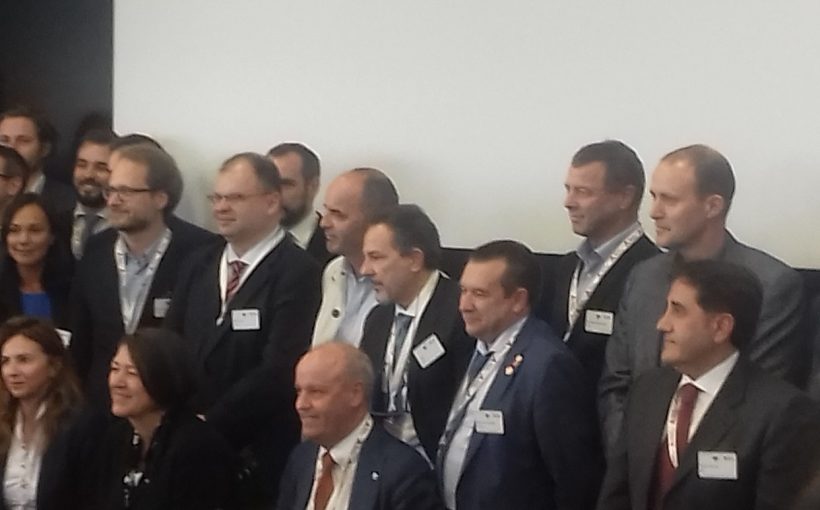By Philip Butterworth-Hayes
The launch on October 19 in Antwerp of the European Union Network of U-space Demonstrators by transport commissioner Violete Bulc is a bold and well formulated strategy for Europe to integrate its multiplicity of drone research programmes within the EU’s aviation regulatory and research frameworks. By aligning U-space operational research with the EU’s ATM masterplan, the SESAR JU’s research programme, the Commission’s “smart city” projects and the European Aviation Safety Agency’s (EASA) programme of introducing performance-based regulations, the network “will build on the on-going work, stepping-up the technology, operational and service learning curve and the associated regulatory frameworks to a level of maturity capable of triggering a whole spectrum of innovative business and service opportunities in the drone marketplace, in particular Beyond Visual Line of Sight (BVLOS) and automated operations,” according to the Commission.
The aims are bold (see “The European Commission’s demonstrator network objectives”) and the research programmes are very carefully chosen to provide a healthy mix of niche technologies and large-scale echo-system demonstrations. The challenges – especially as they relate to cyber threats, liabilities and gaining public acceptance – are clearly understood.
But there are two strategic threats which will need to be carefully managed by the support cell – comprising Eurocontrol, the European Aviation Safety Agency and the SESAR JU. This body will play the crucial role of developing an inventory of all projects within the EU demonstrator network, monitoring the actual performance of U-space implementations; providing a repository of best practices to support operators and regulators on managing the Specific Operations Risk Assessment (SORA) process, an open discussion forum and a “Handbook for Regulators”, including a proposed process and supporting guidance for approval of U-space implementation, based on the experiences gathered from the demonstrations.
“EASA will establish an informal group that will work with demonstrators to develop a regulatory model for U-space,” according to Maria Algar-Ruiz, coordinator of all U-space activities at EASA, at the Antwerp launch event. “The Agency will also support with regulators, competent authorities and operational stakeholders to ensure that drone operations will meet required levels of safety and environmental impact.”
These two threats are: mission creep and swamping the policy makers with too much data.
In her speech in Antwerp Commissioner Bulc said the network will be open to non-EU contributors and asked, rhetorically, whether U-space might also guide future modes of surface transport – logical but dangerous.
Regulators and transport policy makers will need just the right amount of data to begin the process of turning demonstrator results into real standards and regulations. Too much – especially from programmes with different results from slightly different technologies and procedures – and suddenly this task moves from challenging to impossible. This means someone is going to have to say “Thanks but no thanks” to an unending line of potential collaborators and partners from all parts of the world – unless, of course, they bring with them huge amounts of investment, because this programme will only be sustainable if industry beyond Airbus starts making some major contributions.
Too many projects, too much research and suddenly the network will no longer be an accelerator but a decelerator.
U-space regulations will based on new performance-based concepts rather than tried and tested technology specific regulations. Although this is the best way to go there will be many aviation safety regulators shaking their heads at the prospect of developing aviation safety regulations covering machine learning, artificial intelligence, blockchain transactions, the Internet of Things to the process of keeping aircraft safely apart, and they will wonder whether the old ways of regulating technology by understanding all of its strengths and weakness might not be best way after all.
Because the real challenge will be to understand how these new concepts will operate at the margins – where sudden and unpredictable gusty squalls could suddenly take drone operations beyond their design operating limits; where UTM based messages conflict with the drone’s own detect and avoid on-board system commands (a la TCAS); and where there are discrepancies in the drone operator’s view of the airspace and the UTM operator’s views.
The other threat is to look at how digitisation is impacting the overall air traffic management sector. While it is certainly true that UTM must be somehow operationally and regulatorarily (sic) aligned to legacy ATM systems, a new generation of airspace users flying vehicles above 60,000ft and unmanned ground and maritime vehicle operations it is how this alignment takes place that is important. Someone, again, is going to have to say “I understand there are other stakeholder interests involved but this is what we are going in UTM and we will align the other interests somehow later on in the process. That, after all, is the beauty of digitisation – alignment will probably just be a software issue.”
Of course it is easy for a commentator to point out the problems. But the problems are not unsurmountable or unrecognised. This is an extraordinarily well-thought out strategy with a genuinely exciting vision at its heart.
| The European Commission’s demonstrator network objectives
The EU Demonstrator network will become the “single point of contact” in Europe for U-space implementations. It will lead to
It will also lead to Better Regulation: creating opportunities for Member States regulatory authorities to collaborate in devising consistent and, as far as practicable, harmonised due processes for approval of U-space implementations; this would encompass notably issues relating to:
|




